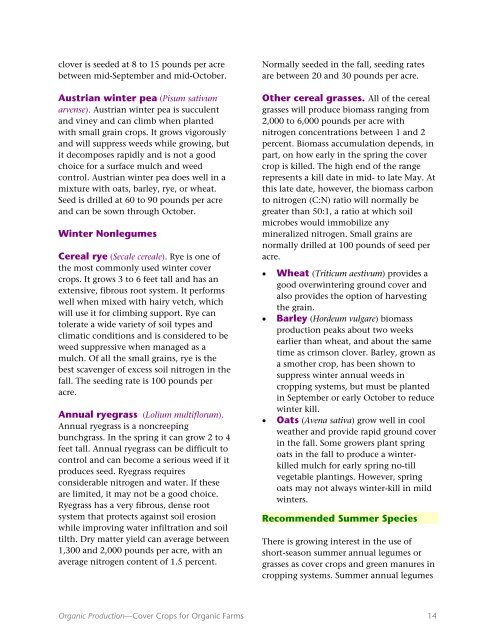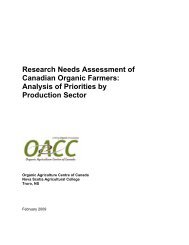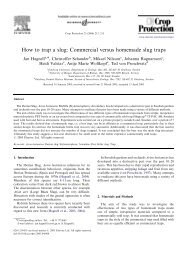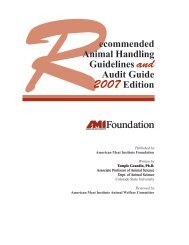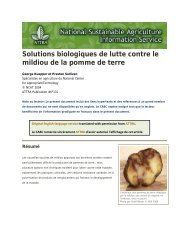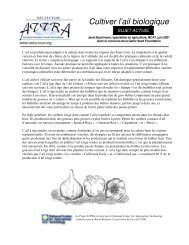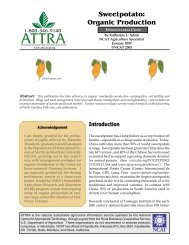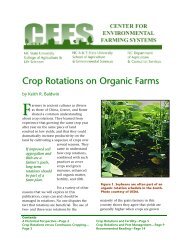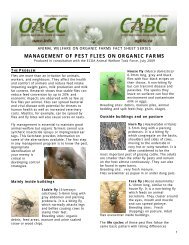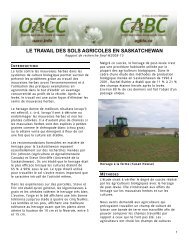clover is seeded at 8 to 15 pounds per acrebetween mid-September and mid-October.Austrian winter pea (Pisum sativumarvense). Austrian winter pea is succulentand viney and can climb when plantedwith small grain crops. It grows vigorouslyand will suppress weeds while growing, butit decomposes rapidly and is not a goodchoice <strong>for</strong> a surface mulch and weedcontrol. Austrian winter pea does well in amixture with oats, barley, rye, or wheat.Seed is drilled at 60 to 90 pounds per acreand can be sown through October.Winter NonlegumesCereal rye (Secale cereale). Rye is one ofthe most commonly used winter covercrops. It grows 3 to 6 feet tall and has anextensive, fibrous root system. It per<strong>for</strong>mswell when mixed with hairy vetch, whichwill use it <strong>for</strong> climbing support. Rye cantolerate a wide variety of soil types andclimatic conditions and is considered to beweed suppressive when managed as amulch. Of all the small grains, rye is thebest scavenger of excess soil nitrogen in thefall. The seeding rate is 100 pounds peracre.Annual ryegrass (Lolium multiflorum).Annual ryegrass is a noncreepingbunchgrass. In the spring it can grow 2 to 4feet tall. Annual ryegrass can be difficult tocontrol and can become a serious weed if itproduces seed. Ryegrass requiresconsiderable nitrogen and water. If theseare limited, it may not be a good choice.Ryegrass has a very fibrous, dense rootsystem that protects against soil erosionwhile improving water infiltration and soiltilth. Dry matter yield can average between1,300 and 2,000 pounds per acre, with anaverage nitrogen content of 1.5 percent.Normally seeded in the fall, seeding ratesare between 20 and 30 pounds per acre.Other cereal grasses. All of the cerealgrasses will produce biomass ranging from2,000 to 6,000 pounds per acre withnitrogen concentrations between 1 and 2percent. Biomass accumulation depends, inpart, on how early in the spring the covercrop is killed. The high end of the rangerepresents a kill date in mid- to late May. Atthis late date, however, the biomass carbonto nitrogen (C:N) ratio will normally begreater than 50:1, a ratio at which soilmicrobes would immobilize anymineralized nitrogen. Small grains arenormally drilled at 100 pounds of seed peracre.• Wheat (Triticum aestivum) provides agood overwintering ground cover andalso provides the option of harvestingthe grain.• Barley (Hordeum vulgare) biomassproduction peaks about two weeksearlier than wheat, and about the sametime as crimson clover. Barley, grown asa smother crop, has been shown tosuppress winter annual weeds incropping systems, but must be plantedin September or early October to reducewinter kill.• Oats (Avena sativa) grow well in coolweather and provide rapid ground coverin the fall. Some growers plant springoats in the fall to produce a winterkilledmulch <strong>for</strong> early spring no-tillvegetable plantings. However, springoats may not always winter-kill in mildwinters.Recommended Summer SpeciesThere is growing interest in the use ofshort-season summer annual legumes orgrasses as cover crops and green manures incropping systems. Summer annual legumes<strong>Organic</strong> Production—<strong>Cover</strong> <strong>Crops</strong> <strong>for</strong> <strong>Organic</strong> <strong>Farms</strong> 14
and grasses can provide benefits betweenthe harvest of spring vegetable crops andthe planting of fall vegetables or smallgrains. While additional legumes andgrasses are being evaluated <strong>for</strong> use, thefollowing species are currently the bestoptions.Summer LegumesCowpea (Vigna unguiculata). Othercommon names <strong>for</strong> this species areblackeyed, crowder, and southern pea.Cowpea is a fast growing, summer covercrop that adapts to a wide range of soilconditions. Cowpeas have a deep taproot,tolerate drought, and compete well againstweeds. Cowpeas produce 3,000 to 4,000pounds of dry biomass per acre, whichcontains 3 to 4 percent nitrogen. Maximumbiomass is achieved in 60 to 90 days.Residues are succulent and decomposereadily when incorporated into the soil.Cowpeas can be planted in the spring (afterall danger of frost) through late summer.Cowpea seeds can be drilled in rows 6 to 8inches apart at 40 pounds per acre or broadcastat approximately 75 pounds per acre.Higher seeding rates are necessary in latesummer when soil moisture is likely to belimited. Recommended cultivars includeIron Clay and Red Ripper. Plants normallygrow up to 24 inches tall, but some cultivarscan climb when planted in mixtureswith other species. Good mixture optionsare sorghum-sudangrass and Germanfoxtail millet. When mowed or undercut,cowpeas have the potential <strong>for</strong> considerableregrowth in some years.Soybean (Glycine max). Soybean is one ofthe most economical choices <strong>for</strong> a summerlegume cover crop. It is an erect, bushyplant that grows 2 to 4 feet tall, establishesquickly, and competes well with weeds.When grown as a green manure crop, latematuring cultivars usually give the highestbiomass yield and fix the most nitrogen. Ifwell established, soybean will withstandshort periods of drought. The viney, <strong>for</strong>agetypes (<strong>for</strong> example, the cultivars Quailhavenand Laredo) have the potential toproduce more biomass than traditionalsoybean cultivars.Velvetbean (Mucuna deeringiana).Velvetbean is a vigorously growing, warmseasonannual legume native to the tropicsand well adapted to southern U. S. conditions.It per<strong>for</strong>ms well in sandy and infertilesoils. Most cultivars are viney, andstems can grow as much as 10 meters.Velvetbean is an excellent green manurecrop, producing high amounts of biomassthat decompose readily to provide nitrogen<strong>for</strong> a cash crop. Velvetbean does best whendirect-seeded into warm soils in 38-inchrows. Velvetbean seed should not bedrilled, because the very large seed can bedamaged in conventional drills.Sunnhemp (Crotalaria juncea). Sunnhempis a tall, herbaceous, warm-season annuallegume with erect fibrous stems. It has beenused extensively <strong>for</strong> soil improvement andgreen manuring in the tropics. It competeswith weeds, grows rapidly, and can reach aheight of 8 feet in 60 days. It can toleratepoor, sandy soils and drought, but requiresgood drainage. Sunnhemp toleratesmoderate acidity, but a soil pH below 5 canlimit growth. Sunnhemp should be drilledor seeded in rows 38 inches apart at 30pounds per acre. The growing season in thecontinental U.S. is not long enough toproduce viable seed. Sunnhemp becomesfibrous with age, but the plants aresucculent <strong>for</strong> about eight weeks afterseeding. Sunnhemp is often planted inmidsummer after cool-season vegetables orsweet corn crops are harvested. It willproduce high biomass and biomass<strong>Organic</strong> Production—<strong>Cover</strong> <strong>Crops</strong> <strong>for</strong> <strong>Organic</strong> <strong>Farms</strong> 15


